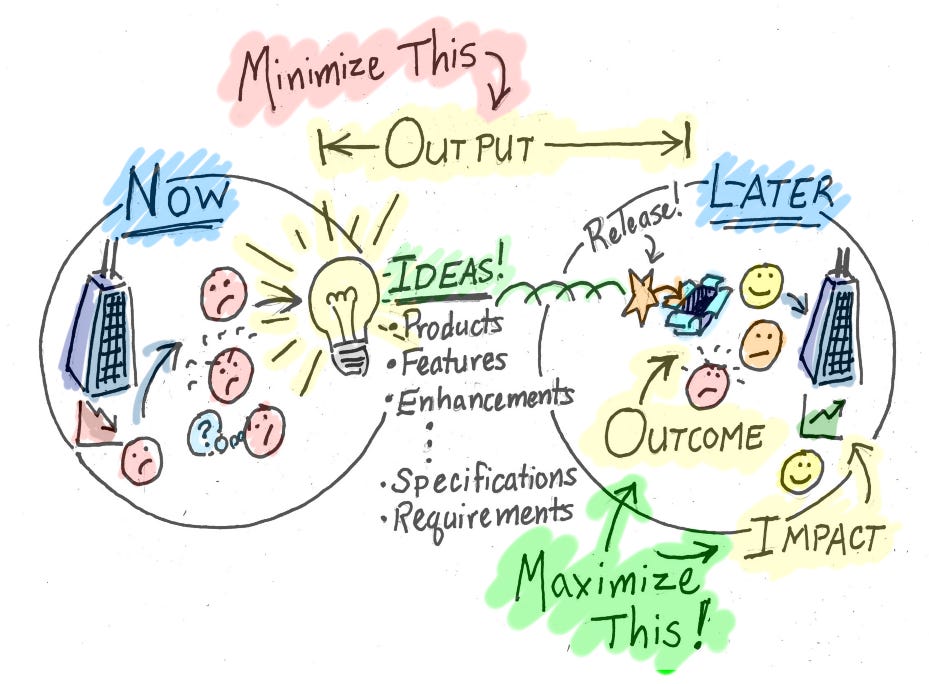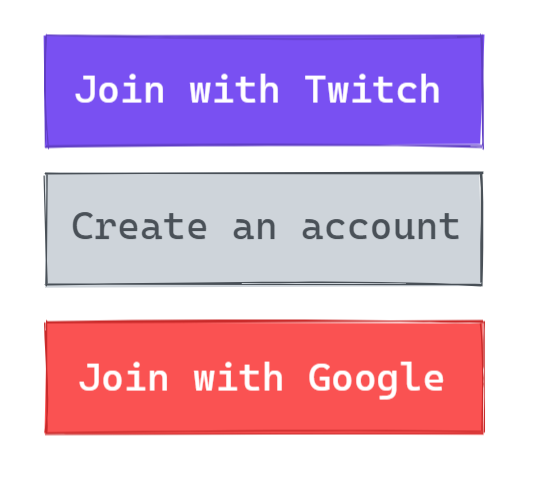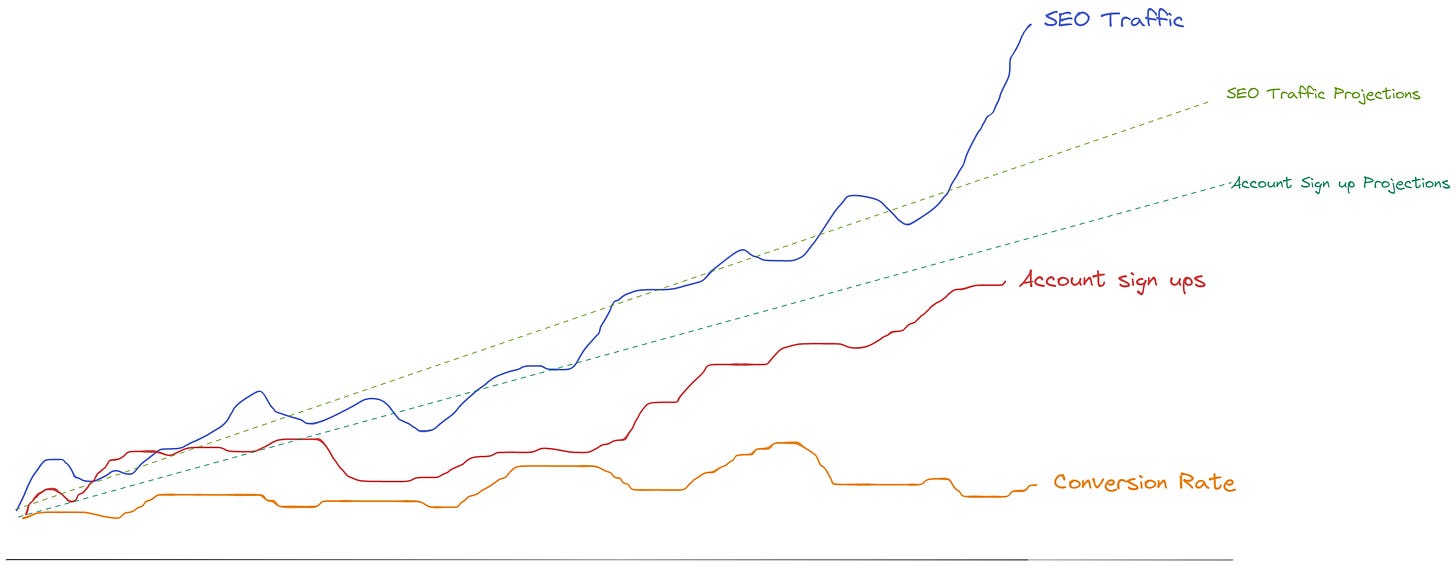A newsletter for technical SEOs to learn product and agile skills so they can work with development teams to get recommendations implemented.
The most successful product and engineering teams in the world have learned to focus on solving customer problems rather than just shipping deliverables.
How do they do this? They focus on measuring outcomes not focusing on outputs.
At DeepCrawl we began to integrate outcome targets as part of our key results and it helped us prioritise code releases to focus on solving customer problems, rather than just shipping code.
The TL; DR
In this newsletter I will go through:
The problem with a deliverables mindset
A real-world example of outcome targets in action
Defining outcomes, outputs and impact metrics
Examples of using outcome targets in technical SEO
For any SEO wanting to better understand product mindset and how to work with developers, the shift to an outcome mindset is an important concept to grasp.
The Problem with a Deliverables Mindset
A website is never finished.
When are Amazon, eBay or Wayfair website’s ever complete? The truth is they are never “done”, teams just decide to prioritise a new idea.
So, if a website is never complete how can we make sure our SEO strategy, checklists and KPIs are focusing on the right deliverables? How do we know they are driving business results?
Page load speed optimisation projects are a very good reflection of this concept in action.
For years it has been a known fact that site speed impacts the bottom line of a business. Yet, many brands and website owners have only really begun improving page load speed since the launch of Core Web Vital metrics.
However, the focus on simply hitting the Core Web Vital metric scores is an output focused mentality. The result of focusing on deliverables raises a number of questions from internal stakeholders around dealing with site speed:
How do page load speed optimisation work change user behaviour?
How many changes do we need to make before it has a positive impact?
How do you know the changes you made have a positive effect on driving results?
These key questions are what outcomes can help teams answer.
An outcome is what happens when you change human behaviour that drives business results by working on the right deliverables.
It doesn’t matter if we achieve the change from one deliverable or a hundred, the important thing is changing customer behaviour that drives business results.
In large organisations where priority and resource are key, making sure you are working on the right deliverables is critical.
Let's take a look at a real-world example of the outcomes to get a better understanding of them in action.
Focusing on Outcomes: A Real World Example
At Yelp the engineering and UX team wanted to improve the bottom line by investing in reducing the page load speed of the core Yelp ads purchase seven-step process.
The team first identified the behaviour they wanted to change. They wanted to increase the number of users converting in the core ads purchase process (outcome). They also identified the KPI they were going to measure conversion rate (impact metric) to understand the success of any work done.
Before they invested a lot of time and resources into improving the page load speed of the website they did an experiment. They found that by making backend optimisations and reducing page load speed by 1 second they increased the relative conversion rate by 12%.
This experiment showed the value of investing in page speed optimisation changes (outputs) to internal stakeholders. It showed them that technical changes can have a positive impact on user behaviour that drives results.
With buy-in from stakeholders, the team were able to create a roadmap. They also created an automated dashboard using Splunk to monitor page load speed metrics.
The results of the four-month project speak for themselves:
15% lift in conversion rate (impact metric)
Reduced First Contentful Paint (FCP) from 3.25s to 1.80s.
Reduced Time to Interactive (TTI) from 4.31s to 3.21s.
The team at Yelp had an outcome over an output mentality when optimising the page load speed of an app. It was about changing user behaviour and measuring that impact.
Outcome-based targets help teams work on the right things that change customer or user behaviour which leads to positive things for the company.
Output-based roadmaps do not take into account human behaviour and can make teams prioritise deliverables that have no impact on business results.
Defining outcomes, outputs & impacts
Now we’ve gone through an example let's jump into defining these concepts.
What is an Outcome?
The definition of an outcome is:
“An outcome is a change in user or customer behaviour that drives business results.”
- Joshua Seiden, Outcomes over Outputs
An outcome has nothing to do with releasing code, publishing a piece of content or building a link. Those are all outputs.
Instead, outcomes are a simple way of highlighting what the business wants to achieve by changing user behaviour.
The change in user behaviour might be:
Customers signing up for a newsletter
Customers buy a product
Customer filling in an application form
Customers satisfied that content has answered their question
Think of an outcome as a way to measure success based on positive user or customer behaviour. It’s what you want customers to do to drive business results.
What is an Output?
The definition of an output is:
“An output is the change you make to influence user or customer behaviour.”
- Joshua Seiden, Outcomes over Outputs
An output is simply deliverables or a tactic that you assume will impact business results.
These tactics in SEO could be:
Writing and publishing content
A link campaign
Optimising title tags
A technical SEO audit
A code change
It is always important to remember that the number of outputs delivered is not a measure of progress or success.
Especially in an uncertain environment like SEO. Any SEO deliverable should always be tied to a wider business strategy and use outcome targets and impact metrics to measure business results.
What is the Impact Metric?
The definition of an impact metric is:
“The key result or goal you want to track to measure the success of project or recommendation.”
- Joshua Seiden, Outcomes over Outputs
The measurement of impact metrics is key when using outcomes, as it allows the team to understand if their ideas or tests are having on user behaviour.
In most organisations the executives of the business are going to state that the business metric is going to be:
Increase revenue
Reduce costs
Increase market share
In smaller businesses, these metrics can be influenced by an individual or a team but in larger enterprise organisations these impact metrics aren’t going to be achieved by one team.
Instead in larger organisations teams should break down top-level impact metrics into smaller more actionable goals to track outcomes. For example smaller impact metric could be:
Churn rate
Conversion rate
Customer satisfaction survey
Abandonment rate
In both small and larger organisations there are going to be a variety of factors that will stop your team from changing customers behaviour.
The measurement of key impact metrics allows teams to highlight that other work is needed to be prioritised (e.g. CRO, design or content).
In product teams, this is exactly what outcome targets are meant to encourage.
They help guide product and engineering teams to ask questions which focus on solving customer problems, rather than just rolling out another code change. This helps them work on priority tickets that help drive business results.
Whatever the business metric is chosen it's important to make sure:
Impactful changes - The outcome and outputs will actually affect the metric you’re measuring.
Automate feedback - The metrics should be measured using automated reporting (Data Studio, PowerBi, etc.)
Team alignment - The team and higher management are aligned on the business metrics you’re tackling.
Metrics - Track between 1-3 impact metrics to measure positive user behaviour.
At DeepCrawl we combined an outcome-based product roadmap in conjunction with Objectives and Key Results (OKRs) to track progress.
The company would set business impact metric targets and each team created their own achievable key results and roadmap which would drive the wider business impact metrics.
These were tracked on a quarterly basis to make sure we were on track and if not learn why we weren’t hitting targets.
Technical SEO and Outcome Examples
I’ve talked a lot about theory and concepts so far. Let's go through some examples of how technical SEO could use outcome targets to drive business results.
Enterprise SEO: Increase customer sign up
An enterprise company with 5 million pages wants to increase the number of new account sign-ups, which help them capture customer emails, year-on-year (outcome).
The product and SEO team need to help increase account sign-ups +25% year on year (impact metric). The product team is focused on improving conversion rates and number of account sign ups.
It’s up to the SEO team to help drive more organic search traffic which should directly help drive account sign-ups.
The SEO team identifies opportunities (outputs) that can help meet this target:
Inactive pages indexed - 70% of the website has inactive pages (no impressions or visits) and a noindexing strategy needs to be developed.
Poor cross-linking - There is poor internal linking to important converting page templates and other popular areas of the website.
Duplicate and similar content - The team identifies that 20% of the indexable pages are 95% duplicated and need a canonical strategy to help Google fold signals into the primary canonical URLs.
JavaScript SEO - The team identifies that critical content relies on onclick events to load in the rendered HTML and the critical content needs to rendered server-side.
A discussions with developers allow the team to create a product backlog of projects and tasks that can be moved into the dev backlog once ready to be worked on.
Nine months into the campaign, the SEO and product team notice that technical recommendations are helping drive more SEO traffic BUT the number of account sign-ups aren’t increasing.
The product team can pivot more resources and time on why customers aren’t signing up and develop ideas, hypothesize and develop A/B split tests to try to solve this problem.
The SEO team has achieved key results but the outputs haven’t positively changed user behaviour.
This doesn’t mean the SEO or product team failed it just highlights that more CRO experiments and testing needs to be done rather than churning out SEO deliverables. The outcome-targets allow SEO and product team to ask:
Why aren’t more visitors increasing product sales?
How can we get more potential customers to buy a product?
How can we measure any changes we make?
How can we make sure any changes don’t impact on SEO performance?
These questions can lead to further experiments, A/B split testing and other changes which drive business results. This shift in mindset can help teams focus less on releasing code, and more on solving customer pain points.
Ecommerce SEO: Increase the number of customers buying products
An ecommerce business with a 1 million page website wants to increase the number of product bought by customers (outcomes) and notices that the SEO channel isn’t performing as well as it should.
The SEO manager calculates using projections they will need to increase their SEO traffic by 30% YoY (impact metric) based on a certain conversion rate to hit +15% revenue target (impact metric).
Once a technical SEO audit had been completed the highest priority actions (outputs) which would help achieve the key results are:
Product page importance - The link architecture of the website is giving more importance to non-indexable product pages and the logic of internal linking needs to be reviewed to make indexable pages a priority.
Product internal linking - The pagination, related product links on product pages and category pages need to be updated to help reduce click depth to indexable product pages.
Duplicate content - Technical content quality issues need to be addressed and a canonical strategy needs to be put in place.
Inactive product pages - 52% of the website has inactive indexable product pages with no impressions or visits and a noindex strategy needs to be developed.
All of these issues are discussed and prioritized into a technical SEO backlog based on the feasibility and capacity of the engineering team.
Six months into implementing the technical recommendations the team is starting to see SEO traffic growth.
However, what the team notice is that although SEO traffic is increasing the number of “last click” sales attributed to organic search isn’t increasing. A quick exploration of the analytics tracking finds that actually clicks from SEO aren’t being attributed properly.
The development and insights team (who were alerted to the issue) need to make further changes to the custom analytics platform.
Again, this isn’t a failure but a learning for the team. They need to start investing in accurately tracking customer acquisition channels. The shift in an outcome mindset allows teams to think more about measuring success of changing customer behaviour.
Summary: Outcomes over outputs in SEO
As I said at the beginning of this newsletter, a website is never finished.
A shift in an outcome mindset can help SEOs better understand how to shift focus from a delivery mindset to thinking more about how they can change customer behaviour that drives results.
In the product industry successful teams use the outcomes to change customer behaviour to drive results, prioritise never-ending dev backlogs and measure the success of code releases.
If you want to learn more about outcomes I have provided a list of resources below to read.
Further reading:









